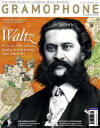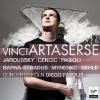Texte paru dans: / Appeared in:
*

GRAMOPHONE
Pour s'abonner /
Subscription information
Virgin
6028692

5099960286925 (ID253)
Consultez toutes les évaluations recensées pour ce cd
~~~~ Reach all the evaluations located for this CD

Reviewer: David Vickers
The rehabilitation of Leonardo Vinci (c1696-1730)
has been long overdue. He trained at the Conservatorio dei Poveri di Gesù Cristo
in Naples, where he made his debut as an opera composer in 1719. During the next
decade Vinci worked for prestigious opera houses in Rome and Venice, and his
swift ascent coincided with that of his influential literary collaborator
Metastasio. Their ambitious new serious opera Artaserse was unveiled on
February 4, 1730, at Rome’s Teatro delle Dame, where it was performed by an
all-male cast on account of the peculiarities of papal dislike of women
appearing publicly onstage in the Eternal City (a different setting of
Metastasio’s new libretto was unveiled in Venice only seven days later by Hasse,
whose cast included women). At the apex of his meteoric career Vinci thed
suddenly in Naples, aged only about 34 and under suspicious circumstances; it
was rumoured he had been poisoned.
Posterity has been unkind to the Neapolitan master, although he was esteemed highly by his contemporaries Vivaldi and Handel, who retained 20 of Vinci’s numbers when he adapted Artaserse for the London pasticcio Arbace in 1734. The odd aria and a few chamber cantatas have been recorded here and there, and some inroads were made by Antonio Florio’s recordings of the comic opera Li zite ‘ngalera (Opus 111) and, more recently, La Rosmira fedele (mistitled Partenope on its premiere recording — Dynamic, 10/12). Now the composer’s visibility and reputation are emphatically rehabilitated by this advocacy of Artaserse masterminded by Max Emanuel Cencic.
The only mild obstacle to dramatic clarity during this outstanding performance is Cencic’s determination to replicate Vinci’s all-male cast by initiating a countertenor-laden experiment; he chooses for himself the ‘prima donna’ role of Mandane. To be fair, the five countertenors are cast shrewdly to sound dissimilar; but Philippe Jaroussky’s sweet Artaserse is more effeminate than his love interest Semira (the gutsier Valer Barna-Sabadus). Perhaps seeing drag queens onstage would clear things up but the plethora of countertenors singing varying gender roles makes it essential to follow Metastasio’s fine libretto closely: it is an archetypally tangled political thriller that offers scope for dramatically powerful scenes exploring themes of injustice, loyalty, treachery and love that appealed to many composers for years to come (Metastasio later affectionately called Artaserse ‘the most fortunate of all my children’). Arbace loves Mandane, the daughter of the disapproving Persian king Xerxes, who has banished him from the palace at Susa. He returns secretly to see his lover but is inadvertently framed for his father Artabano’s assassination of the king. The new monarch Artaserse loves his friend Arbace’s sister Semira, and is embroiled in political difficulties and emotional conflicts when the deceiver Artabano plots to overthrow him. The sinister schemes of the traitor are foiled eventually by the honest hero Arbace, who until then has been torn between pressures of filial duty, friendship and love.
An abundance of masterfully contrasted arias poignantly convey the emotional conditions of the respective protagonists. Arbace’s anguish upon discovering his father Artabano’s assassination of the king (‘Fra cento affanni’) is sung spiritedly by Franco Fagioli. Act 1 climaxes with a fantastic sequence of concise arias: the unjustly accused Arbace is renounced robustly by his treacherous father, reluctantly by his tender sister and venomously by his lover Mandane (‘Dimmi che un empio sei’, featuring biting strings and spectacular coloratura from Cencic), after which the bereft hero sings an emotive accompanied recitative and powerful aria di bravura with potent low horn notes (‘Vo solcando un mar crudele’). During Act 2, trumpets and timpani gang, up with Artabano to bully his daughter to accept a man she does not love (‘Amalo e se al tuo sguardo’), whereas the strings in Mandane’s beguiling ‘Se d’un amor tiranno’ suggest she is struggling to relinquish her love for the man she believes murdered her father. The prison scene that begins Act 3 indicates that Vinci was one of the finest opera composers of his age.
Concerto Köln deliver orchestral accompaniments with their customary punchiness, although I doubt that a bassoon really played during all of the villainous tenor’s recitatives. The entire cast produces exceptionally good singing. Cencic and Jaroussky give a masterclass of dramatic countertenor singing, and Valer Barna-Sabadus and Yuriy Mynenko (the dastardly Megabise) are not far behind. Other listeners might find Fagioli’s mannered vowels more pleasing than I do but the technical assurance of his coloratura is impressive. The lone tenor Daniel Behle brings the treasonous Artabano vividly to life and offers excellent declamation of Metastasio’s poetry.
Diego Fasolis ensures that the pacing of the drama is
spot-on, and it is intriguing to experience an original and unabridged setting
of a Metastasio libretto that reveals fascinating virtues and eloquently
developed ideas in the dramatic poetry. The discography of front-rank native
Italian opera composers of the early 18th century has been woefully inadequate
since Edison first tinkered with sound recording (Handel was not Italian and
some might not count Vivaldi as front-rank) but it is bolstered immeasurably by
this sensational landmark recording.
Fermer la fenêtre/Close window
Cliquez l'un ou l'autre
bouton pour découvrir bien d'autres critiques de CD
Click either button for many other reviews


